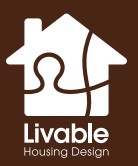Houses have to be prepared not only for the actual characteristics and needs of its occupants, but also taking into account the potential needs that at some point people may experience. And providing good conditions of access and mobility will not suppose any disadvantage but better and more comfortable living conditions, for example at manoeuvring prams, carrying the shopping into the house, to move furniture, or for people with disability or temporary injury to get around and reducing falls and slip-based injuries.
Aditionally, if these features are included when designing the house, is more cost effective, than retrofitting afterwards. “The cost to the homeowner of including key livable housing design features (in this case the silver level) is 22 times more efficient than retrofitting when an unplanned need arises.”
This model establish three levels of performance: silver level, including only the basic requirements focused on the spatial and structural elements; the gold level, which introduces some additional elements in specific rooms such as the kitchen or bathroom. And the platinum level includes features to make houses confortable for ageing people and people with disabilities with higher mobility needs.
The elements considered, with different requeriments depending on the levels of performance are: dwelling access, dwelling entrance, internal doors and corridors, toilet, shower, reinforcement of bathroom and toilet walls, internal stairways, kitchen space, laundry space, ground (or entry level) bedroom space, switches and powerpoints, door and tap hardware, family/living room space, window sills and flooring.
If you would like to know more about the requirements of a liveable house check the document.








